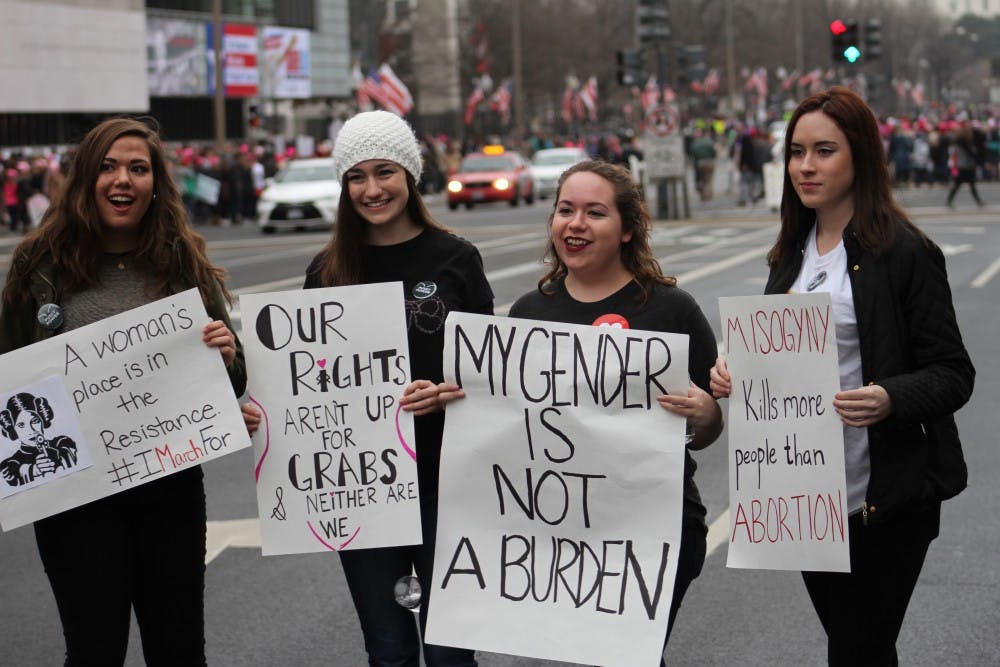Inside AU’s Archives and Special Collections lie posters from Vietnam protests, pro-choice marches, anti-Apartheid rallies and gay rights movements. And now, the department will be home to posters from this January’s Women’s March on Washington.
The archives began a collection in late March of the different signs students held while participating in the protest. Initiated by University Archivist Susan McElrath, the request for posters from the Women’s March was sent out as a way to “bridge the gap between the materials we have related to student protests in the 60s to this other collection looking at student protests on a broader scale,” she said.
AU’s Student Historical Society teamed up with the archives to help publicize the collection of posters. McElrath said the organization set up an event in the Mary Graydon Center to make students aware of the collection as well as to provide a place for them to drop off their signs.
Nana Gongadze, the publicity designer and recruitment manager of the group, was eager to assist in the archives’ effort.
“The Women’s March was such a historic demonstration,” Gongadze, a freshman in the School of Communication, said. “We definitely believe that we should have some historical record of AU students’ attendance.”
The outreach for the protest signs is unique in that the archives are typically not active in their search for materials, McElrath said. Since donations can be made at any time, the owner retains the rights to their pieces, and the donor must ultimately sign off that they are willing to allow their materials to be used by others. If someone wishes to get their donations back, the request would be evaluated by the archives staff on a case by case basis.
“The archives, unlike libraries, have to be more conscious of the fact that when we bring something in, we need to know as much about it as we can so that we can give it the proper care,” McElrath said.
Since the signs have been collected, the archives now have representation of the different motivations for people at the Women’s March, which can be added to their social justice collection.
“The visual diversity of the signs say a lot about the nature of [the] Women’s March,” McElrath said. “It’s sort of a coalition and an umbrella that dealt with a lot of things.”
The AU Archives are comprised of two different types of materials. The first are the archives themselves which “chronicle more than one hundred years of the University's history,” according to the department’s site.
The collection includes documents, films, videos, sound recordings and photographic images from a wide range of categories. There are University publications, records related to buildings and grounds and oral history collections, to name a few. These are typically gathered from the University or put in the archives at the end of their necessity.
The second type of materials are the special collections which hold materials of different themes and events from history; this is where the Women’s March posters would be featured. Other pieces similar to these are held in the Patrick Frazier Political and Social Movements Collection. According to its description, “this collection contains broadsides, flyers, handbills, photographs and posters and covers all of the major political and social movements of the 1960s and 1970s.”
McElrath said the collection features posters from the Vietnam War protests, pro-choice marches, anti-Apartheid and gay rights movements, all of which are events AU students have participated in over time. The signs from the Women’s March would add another piece of history to this collection.
“Because we have a social justice theme in special collections, that was why we went out to collect the posters,” McElrath said.
At this point, the Archives have five posters from student donations and they will be collecting posters through the end of the semester, McElrath said.
Aside from the poster collection, the Archives will be moving its central location from the second floor of Bender Library to the Spring Valley Building.
McElrath said the relocation will allow for staff members to work in a consolidated space and collections will all be stored in the same location. The new space will allow for a reading room which gives them a place to work with classes. Another benefit is the climate controlled exhibit space.
“The new space will put everything in one room which will be really nice,” McElrath said.
Although they will no longer be on main campus, they still encourage students and faculty to use their resources at the newly centralized location. Access to these materials can be found online in their digital repository, online exhibits and their blog.





